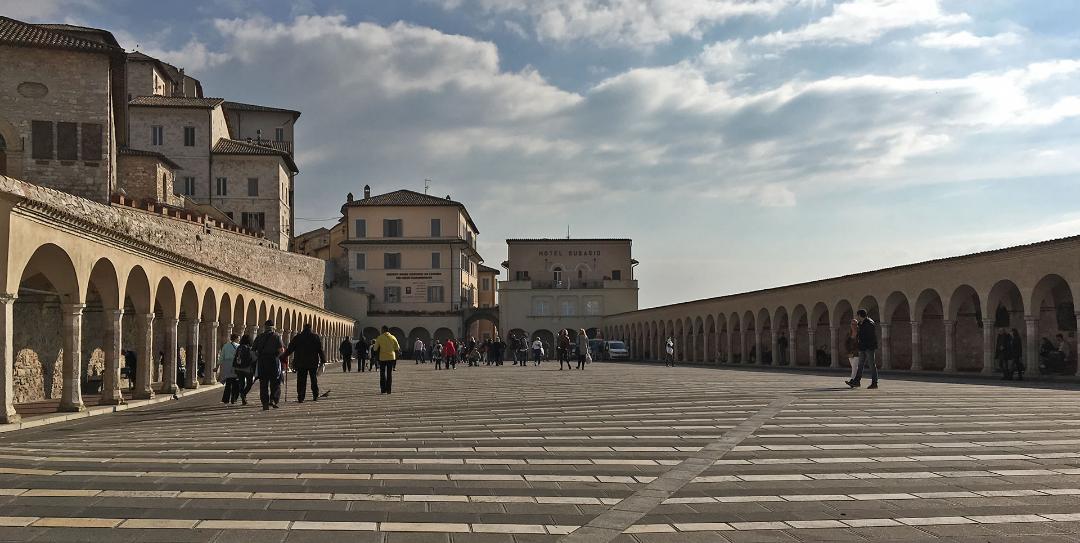LOWER BASILICA
It is accessed from the side of the basilica, through a double portal from the end of the 13th century, surmounted by a Renaissance porch.
The interior has a single nave, divided by low arcades into five bays; the side chapels were opened later, at the end of the 13th century.
On the walls of the nave are the remains of frescoes with Scenes from the Passion of Christ (right) and Stories from the Life of St Francis (left), the work of the so-called Master of St Francis (around 1253).
The first chapel on the left is dedicated to a cycle on the life of St Martin, frescoed by Simone Martini, one of the greatest artists of the 14th century. Commissioned and financed by Cardinal Gentile Partino da Montefiore, it was painted by the Sienese master from 1313 to 1318.
Halfway down the nave, there is a staircase leading down to the crypt with the urn containing the Saint's remains.
Almost at the end, on the same wall, in a niche above a Gothic tribune, there is a fresco of the Coronation of the Virgin and two Stories of St. Stanislaus by Puccio Capanna (14th century), a Giottesque painting of the highest quality and sweetest pictorial effect.
In the cross vault, above the Gothic high altar, other frescoes are attributed to Giottesque artists, including the Master of the Sails.
On the walls and on the barrel vault of the right transept, there are other frescoes from the school of Giotto and a Madonna Enthroned with Angels and St Francis, a grandiose composition by Cimabue that has been partially deconstructed. On the adjoining back wall, five figures of saints are attributed to Simone Martini.
On the walls and on the vault of the left transept, one can admire, among other paintings, the cycle with the Passion of Christ and a Madonna and Saints by Pietro Lorenzetti and workshop (1315-20).
The chapel of St Nicholas also contains frescoes of the Giotto school, almost certainly by the same master, depicting stories of the saint (1300-1310).
Returning to the nave, on the right, is the chapel with Stories of Magdalene, Lazarus and Martha, painted by Giotto and his collaborators in the first decade of the 14th century.
UPPER CHURCH
If the lower basilica, secluded and shadowy, was dedicated to recollection and penitence, the upper one is soaring towards the sky, airy and luminous.
Gothic in style with French influences, it has a nave divided into four bays, cross vaults, transept and polygonal apse.
The transept is beautifully decorated with frescoes by Cimabue, with the famous Crucifixion, Scenes from the Apocalypse and the Stories of St. Peter. Begun in 1277, the cycle has deteriorated due to the alteration of the white colour into dark tones; this has generated a 'negative' viewing effect.
Also by Cimabue and collaborators are the four Evangelists painted in the vault above the Gothic high altar, and the frescoes with the Stories of Mary on the walls.
In the upper portion of the nave is a cycle of frescoes, with Stories from the New and Old Testament, believed to be partly the work of painters of the Roman school and partly of followers of Cimabue.
The narrative space is interspersed with windows adorned with medieval stained glass windows, which, despite their reconstruction, constitute one of the most complete collections in Italy.
In the lower half of the nave, is the famous cycle of frescoes that had Giotto as both artist and supervisor. It depicts episodes from the life of St Francis, from his youth to his death to the alleged posthumous miracles, inscribed in painted architecture representing columns and corbels. This cycle was executed between 1290 and 1295, while the works in the Lower Basilica date back to the early 14th century.
It was with these early frescoes that Giotto sparked an artistic revolution, overcoming the Byzantine tradition that had reigned in painting until then.
Museum of the Treasury of the Basilica of St Francis
From the first floor of the Renaissance Cloister of Sixtus IV, one enters the Treasury Museum, a collection of sacred art that includes paintings, gold jewellery and textile artefacts related to the history of the basilica.
In the adjacent room is the Perkins Collection, donated to the Sacro Convento by the American art historian Frederik Mason Perkins (1874-1955). Before moving to Assisi, Perkins had also lived in Rome and Siena. During the Second World War, Perkins was imprisoned in Perugia and the collection seized. Of the one hundred and thirty-three works, eighteen were requisitioned by the Germans in 1944 and at the end of the war, only four returned to their rightful owner.
Very important works are preserved in the museum: by Pietro Lorenzetti, Lorenzo Monaco, Sassetta, Beato Angelico, Taddeo di Bartolo, Lorenzo di Niccolò, the Master of San Martino, and a series of 15th-century anti-Semitic panels depicting the Legend of the Cross.
For more information:
Information and Welcome Office
Basilica di San Francesco Assisi
Piazza San Francesco, 2 - 06081 Assisi (PG) - Tel +39 075 81 90 084 - Tel +39 075 81 90 170
www.sanfrancescoassisi.org - info@sanfrancescoassisi.org


































